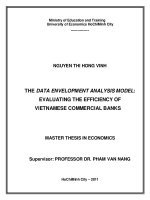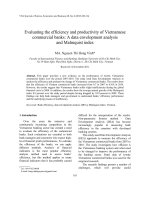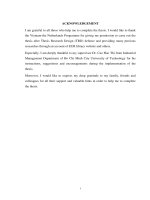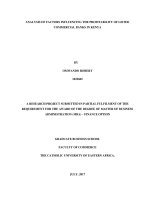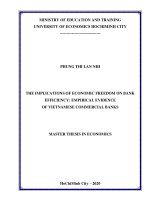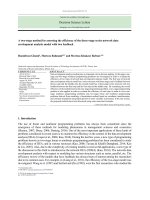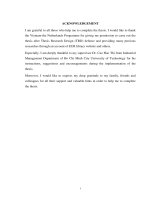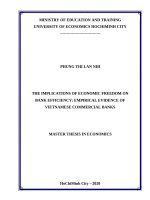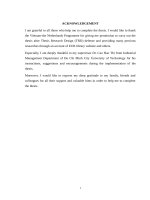The data envelopment analysis model evaluating the efficiency of vietnamese commercial banks
Bạn đang xem bản rút gọn của tài liệu. Xem và tải ngay bản đầy đủ của tài liệu tại đây (1.04 MB, 91 trang )
Ministry of Education and Training
University of Economics HoChiMinh City
----------------
NGUYEN THI HONG VINH
THE DATA ENVELOPMENT ANALYSIS MODEL:
EVALUATING THE EFFICIENCY OF
VIETNAMESE COMMERCIAL BANKS
MASTER THESIS IN ECONOMICS
Supervisor: PROFESSOR DR. PHAM VAN NANG
HoChiMinh City – 2011
Ministry of Education and Training
University of Economics HoChiMinh City
----------------
NGUYEN THI HONG VINH
THE DATA ENVELOPMENT ANALYSIS MODEL:
EVALUATING THE EFFICIENCY OF
VIETNAMESE COMMERCIAL BANKS
Major:
Banking and Finance
Major code:
60.31.12
MASTER THESIS IN ECONOMICS
Supervisor: PROFESSOR DR. PHAM VAN NANG
HoChiMinh City – 2011
i
Acknowledgement
First and foremost, I offer my sincerest gratitude to my supervisor, Professor Dr.
Pham Van Nang for his continuous support during my research, for his patience,
motivation, enthusiasm, and immense knowledge. His guidance helped me in all the
time of research and writing of this thesis. I could not have imagined having a better
advisor and mentor for my Master study.
I gratefully acknowledge all the members of the proposal examination committee
for their valuable comments and constructive suggestions.
I would like to express my sincere gratitude to all instructors and staff at Faculty of
Banking and Postgraduate Faculty, University of Econimics HoChiMinh City for their
support and the valuable knowledge during my study in UEH.
My special gratitude is extended to my English teacher, Mr. Paul Scott, for his
grammatical proofreading of the Thesis draft. I am much indebted to Mr. Scott for his
precious time to read this thesis and gave his critical comments about it.
It is a pleasure to pay tribute also to the Dr. Le Phan Thi Dieu Thao and my
colleagues at the International banking faculty, University of Banking Hochiminh City
for offering me opportunity to study and finish the Master course.
Lastly and most importantly, I wish to thank my beloved parents, and my fiancé,
Ho Xuan Hien. Also, I give thanks to the one above all of us, the omnipresent Father
for His endless love and spiritual support during the completion of this project.
ii
Abstract
The thesis investigates the efficiency of a sample of Vietnamese commercial
banks for the period of 2007-2009, by using the Data Envelopment Analysis (DEA)
approach. After analyzing, the research concludes that the technical efficiency of these
banks was, on average, increasing from 0.683 in 2007 to 0.864 in 2009.
It was also found that the average cost efficiency of the sampled banks was 53.7
percent, and the average annual growth of the Malmquist index was negative 2.6
percent over the study period; however, there is still an opportunity to improve this
indicator. The results presented in the thesis will be helpful to bank managers in
identifying their banks‟ efficiency performance and the underlying reasons for their
successes or failures. It will also help banks in strategic planning, and help policy
makers in their attempts to improve the overall efficiency of the banking industry and
identify the need for reforms of the domestic banks.
KEY WORDS: Data Envelopment Analysis (DEA), efficiency, commercial banks,
Vietnam.
iii
Table of Contents
Acknowledgement ....................................................................................................................... 2
Abstract ......................................................................................................................................... ii
Table of Contents........................................................................................................................ iii
List of Tables............................................................................................................................... vi
List of Figures ............................................................................................................................ vii
Abbreviations ............................................................................................................................viii
Chapter 1: Introduction to the study .................................................................................... 1
1.1
Introduction ................................................................................................................... 1
1.2
Research background ................................................................................................... 1
1.2.1 Rationale of the study................................................................................................ 1
1.2.2 Overview of the Vietnamese banking system ........................................................ 3
1.3
Research objectives and questions.............................................................................. 6
1.3.1
Research objectives ............................................................................................... 6
1.3.2
Research questions ................................................................................................ 7
1.4
Scope and Limitation.................................................................................................... 7
1.5
Research method ........................................................................................................... 7
1.6
Implications of research ............................................................................................... 9
1.7
Structure of the study ................................................................................................... 9
Chapter 2: Literature Review............................................................................................... 11
2.1
Introduction ................................................................................................................. 11
iv
2.2
Commercial banks ...................................................................................................... 11
2.2.1
Definition of commercial banks ........................................................................ 11
2.2.2
Function of commercial banks ........................................................................... 13
2.2.3
Major factors affecting commercial banks‟ performance .............................. 14
2.3 Efficiency and factors affecting efficiency of commercial banks............................. 16
2.3.1
Efficiency.............................................................................................................. 16
2.3.2
Main factors affecting efficiency of commercial banks ................................. 17
2.4 The measurement of efficiency of Commercial banks .............................................. 19
2.4.1 Efficiency analysis by the traditional method of financial indicators ............... 19
2.4.2 Efficiency analysis by parametric frontier efficiency approach ........................ 21
2.4.3 Efficiency analysis by Non-parametric approach (DEA) ................................... 22
2.5 Literature review on measuring efficiency of banking system in Vietnam ............. 25
2.6 Summary .......................................................................................................................... 26
Chapter 3: Research methodology ...................................................................................... 27
3.1 Introduction...................................................................................................................... 27
3.2 Research design ............................................................................................................... 27
3.3 Descriptions of Data Sample and Variables ................................................................ 29
3.3.1 Characteristics of Research Sample on the Vietnamese banks .......................... 29
3.3.2 Description of Variables ......................................................................................... 30
3.4 Data analysis techniques ................................................................................................ 33
3.5 Conclusion ....................................................................................................................... 43
Chapter 4: Empirical results of the research .................................................................... 44
4.1 Introduction...................................................................................................................... 44
v
4.2 Descriptive Statistics ...................................................................................................... 44
4.3 Analysis of Efficiency Estimates .................................................................................. 46
4.4 Productivity Improvement with Malmquist index ...................................................... 53
4.5 Conclusion ....................................................................................................................... 56
Chapter 5: Conclusion and suggestion ............................................................................... 57
5.1
Introduction ................................................................................................................. 57
5.2
Conclusions from the research questions................................................................. 57
5.2.1 Conclusions related to the first question ............................................................... 57
5.2.2 Conclusions related to the second question.......................................................... 59
5.3
Recommendations of the research study.................................................................. 60
5.3.1 Recommendations for Vietnamese commercial banks ....................................... 60
5.3.2 Recommendations for State Banks of Vietnam ................................................... 63
5.3.3 Recommendations for Government ....................................................................... 64
5.4
Contributions of the research findings ..................................................................... 65
5.4.1 Theoretical contribution .......................................................................................... 65
5.4.2 Methodological contribution .................................................................................. 66
5.5
Implications of the research....................................................................................... 66
5.6
Limitations of the research and further research..................................................... 67
5.7
Conclusion ................................................................................................................... 68
References .................................................................................................................................. ix
Appedix ...................................................................................................................................... xii
vi
List of Tables
Table 1.1 Number of commercial banks in Vietnam, 2007-2009 ...................................... 4
Table 1.2 Some developments of Vietnamese banking system (2007-2009).................... 5
Table 3.1 Sample of Vietnamese banks ................................................................................ 29
Table 4.1: Summary of Variables on Vietnamse commercial banks, 2007 -2009 ........... 45
Table 4.2: Technical efficiency of commercial banks, 2007-2009 ................................... 47
Table 4.3: Summary of Estimated Efficiency Measures, 2007-2009 ............................... 49
Table 4.4: Estimated Efficiency Scores for Individual Banks, 2007 -2009 ...................... 50
Table 4.5 Number of banks with DRS, IRS, and Cons, 2007-2009 ................................. 53
Table 4.6: Malmquist Index summary of Annual Means ................................................... 54
Table 4.7 Malmquist Index Summary of Individual Commercial Bank Means, 2007 2009 ........................................................................................................................................... 55
vii
List of Figures
Figure 3.1 Research process................................................................................................... 28
Figure 3.2 Relationship between input-output factors and efficiency of commercial
banks.......................................................................................................................................... 33
Figure 3.3: Technical and Allocative Efficiencies .............................................................. 34
Figure 3.4: Technical and Allocative Efficiencies from an Output Orientation ............. 35
Figure 3.5: Efficiency Measurement and Input Slacks ....................................................... 38
Figure 3.6: Calculation of Scale Economies in DEA.......................................................... 40
Figure 4.1 Trend of interest income and non-interest incomes, 2007-2009 .................... 46
Figure 5.1 The results of TE, PE, SE, AE, CE of 22 Vietnam commercial banks, 2007 2009 ........................................................................................................................................... 58
viii
Abbreviations
DEA
Data envelopment Analysis
DMU
Decision Making Unit
CRS
Constant Returns to Scale Model
VRS
Variable Returns to Scale Model
effch
Technical efficiency change
techch
Technological change
pech
Pure technical efficiency change
sech
Scale efficiency change
tfpch
Total factor productivity change
AE
Allocative efficiency
TE
Technical efficiency
CE
Cost efficiency
PE
Pure technical efficiency
SE
Scale efficiency
TFP
Total factor productivity
irs
Increasing returns to scale
drs
Decreasing returns to scale
cons
Constant returns to scale
EPS
Earnings Per Share
ROA
Return On Assets ratio
ROE
Return On Equity ratio
JOCB
Joint-stock commercial banks
SOCB
State-owned commercial banks
1
Chapter 1: Introduction to the study
1.1
Introduction
This chapter provides a general introduction for the study, section 1.1. Section 1.2
examines the research background in which the gaps in the empirical studies of
commercial banks‟ efficiency are identified, and overview of Vietnamese banking
sector is introduced. Section 1.3 defines the research questions and objectives of the
study.
In addition, section 1.4 discusses scope and some limitations of the current study.
Section 1.5 briefly discusses the general aspects of research methodology such as
research types and research design.
Section 1.6 provides implications of this study. Section 1.7 introduces the structure
of the study. The structure of chapter 1 is provided in Figure 1.1.
1.2
Research background
1.2.1 Rationale of the study
In January 2010, Vietnam concluded three full years of membership in the World
Trade Organization. Along with its integration into the WTO, the banking industry is
experiencing significant changes. The financial liberalization which started in the
1990„s, and continues even is the cause of these important changes. in Vietnam, over
the last twenty years, the financial system in general, and the banking system in
particular, has been transferred from a monopoly system into a diversified system
which allows all participants to compete fairly and effectively.
2
Within these past years, the banking system in Vietnam has gradually developed
by increasing 1.) the number of banking institutions, 2.) the relative size of the
banking sector in the economy, 3.) the amount of credits for the economy, 4.) and the
amount of other banking services.
However, the banking system in Vietnam has affected by the recent world
financial and economic crisis. The negative affects are an increased number of
institutions declaring bankruptcy and instability of the system (proven by the
liquidation crisis at the end of 2008 and the high non-performance loans ratio). .
Despite these affects, our main issue, our overall concern is whether or not
Vietnamese commercial banks are functioning effectively.
Traditionally, the evaluation of banks‟ performance usually employs a financial
ratio method by which it provides a simple description about the bank‟s financial
performance in comparison to previous periods. Thus, bank managers chronologically
measure and compare their efforts. However, a major weakness of ratio analysis is
that there is a lack of agreement in the literature about the relative importance of
various types of indicators. If this study incorporates the related financial indicators to
measure technical efficiency in banks, the n weight assignment to each indicator will
be issued. The financial ratio method can be an appropriate method when firms use a
single input or produce a single output. However, as in many organizations, banks
employ various inputs to provide various services (outputs). Which ratios are selected,
or which measures are chosen, becomes an issue to evaluators, especially when a great
number of related financial indicators are involved. One of the solutions is to
aggregate average among all indicators in order to integrate a single measurement.
DEA approach can be employed to solve the issue of weight assignment. This
approach uses a mathematical programming method to generate a set of weights for
each indicator.
3
So far, there is still a lack of empirical research about the efficiency of the banking
sector in Vietnam over the past decades. The confidential nature of Vietnamese banks
has made it difficult for both foreign and Vietnamese researchers to access critical
data from banking institutions, except for the standard Annual reports.
Therefore, the aim of this paper is to provide an empirical research on the
efficiency of the Vietnamese banking system, in the period of 2007- 2009, in order to
get a brief view of how efficient the banking system is, and what need to change to
improve the performance of this sector. The author uses a data envelopment analysis
(DEA) model for this purpose. The panel data of twenty two Vietnamese commercial
banks was used for the empirical research.
The results presented in this research will be helpful to bank managers in
measuring their banks‟ efficiency performance, and identifying the underlying reasons
for their successes or failures. It will also help banks in strategic planning, and help
policy makers in their attempts to improve the overall efficiency of the banking
industry.
1.2.2 Overview of the Vietnamese banking system
Prior to the Renovation reforms initiated in 1986, Vietnam functioned under a
centrally planned economy: the objectives and modes of production by the
government, not the market. Vietnamese banking could be described as „monobanking system,‟ because the State Bank of Vietnam acted both as a central bank and
a global commercial bank. In fact, before 1988, special purpose banks in areas such as
foreign trade or investment did exist, but they were organized as sub-units of the State
Bank of Vietnam (SBV); moreover, they operated like government organizations
rather than commercial banks. In March 1988, the banking system officially changed
to a two-tier system (Decree No. 53/HDBT of the Prime Minister). Then, the State
4
Bank of Vietnam acted as the central bank, overseeing four (state owned) commercial
banks (SOCB) which specialized in different areas of banking activity.
Almost economists agree that the most significant financial liberalization started in
May 1990, when the two important Decrees were announced: one was the Decree on
the State Bank of Vietnam; and the other was the Decree on Banks, Credit cooperative
and Financial companies. These two Decrees divided the Vietnamese financial system
from monopoly (or one-tier) system into two-tier system: the SBV now mainly acts as
a central bank; other banks and financial companies can have freedom to be
independently established, performed and even closed.
Table 1.1 Number of commercial banks in Vietnam, 2007-2009
Type of banks
State-owned commercial banks
2007
2008
2009
5
5
5
Social policy bank
1
1
Joint-stock commercial banks
34
40
Joint-venture banks
5
5
Foreign bank branches
41
39
Fully foreign owned banks
5
Total
86
95
Source: State Bank of Vietnam, Annual Report, 2007-2009
1
37
5
40
5
93
Table 1.1 shows the number of banks in the system over the period 2007-2009. By
the end of 2009, the financial and banking system developed rapidly: the number of
banking institutions in Vietnam reached 93; the credit institutions comprised of five
state owned commercial banks (SOCB); one social policy bank; 37 joint stock
commercial banks; five joint venture banks; 40 foreign bank branches; and 5 100%
foreign owned banks.
Total equity of credit institutions reached Vietnam Dong (VND) 282,612 billion,
and accounted for 9.32% of total assets, of which, chartered capital was VND 208,873
5
billion. The growth of total equity and chartered capital showed that credit institutions
had focused on internal resources, thus gradually strengthening their financial
capacity. Credit institutions continued to increase their total assets through such
services as fund mobilization from organizations and individuals, credit extension
(loans, guarantees) to the economy and other services. As compared to 2008, total
assets of the entire system increased by 36.39%. The SOCBs‟ assets accounted for the
largest part of the whole system (45.5%, as compared with 51.8% in 2008). The ratio
of non-performing loans over total loan outstanding of the entire credit institution
system stood at 1.99%, lower than the rate of 2.13% at end – 2008
Table 1.2 Some developments of Vietnamese banking system (2007-2009)
Unit:%
GDP growth rate
Deposit growth rate
Credits growth rate
2006
8.20
36.53
25.44
2007
8.50
47.64
53.89
2008
6.18
22.84
23.38
2009
5.32
29.88
37.53
Source: State Bank of Vietnam, Annual Report, 2007-2009
Due to the fast growth of the economy, banking activities experienced very fast
growth during the last few years. At end of 2008, banking sector assets equaled 120%
of GDP. The system is highly concentrated at the top, but fragmented at the bottom.
The largest four SOCBs – including partially privatized Vietcombank and Vietinbank
– control 60% of all assets. Also in 2008, the amount of capital mobilized through the
banking sector was 22.87% (it was in fact nearly 50% in 2007, but decreased in 2008
due to the effect of global financial crisis), in which capital mobilized through State Owned Commercial Banks (SOCBs) was decreasing and capital mobilized through
other commercial banks was increasing (SBV, 2008); hence, the amount of domestic
6
credits that banking sector provided to the economy was nearly comparable with total
GDP (ADB, 2009).
One of the most striking features of the world economy in the period of 2007-2009
was financial crisis which affected all sides of financial markets. This challenged the
banking sector in Vietnam. To overcome the difficulties, Vietnamese commercial
banks must perform more effectively. One of the main problems of the Vietnamese
banking sector, especially the commercial banks, is how to effectively improve their
efficiency and how to foster productivity growth. These are important questions at a
time when opening up the financial market (according to WTO accessing
commitment) is implemented.
1.3
1.3.1
Research objectives and questions
Research objectives
According to Zikmund (1997), a research objective is the researcher‟s version of a
business problem. Objectives explain the purpose of the research in measureable terms
and define standards of what the research should accomplish. In solving the research
problem this study has the following objectives:
- To investigate to the efficiency of the Vietnamese commercial banks .
- To analyze the changes in the productivity and technology of the Vietnamese
commercial banks.
- To contribute to knowledge of measuring efficiency in banking sector.
7
1.3.2
Research questions
Research questions involve the research translation of “problem” into the need for
inquiry (Zikmund 1997). As discussed above, the current research leads to the
following research questions:
Q1. How is the current efficiency of the banking system in Vietnam?
Q2. What effect are the changes in productivity and technology of Vietnamese
commercial banks‟ having on efficiency?
Thus, it is important to answer these questions and from that, a clearer view on the
Vietnamese banking system will be revealed.
1.4
Scope and Limitation
This study was conducted with only 22 Vietnamese commercial banks in the
period of 2007-2009. Additional research with many more banks and larger scope of
whole banking industry is really necessary to precisely assess the scale and measure
efficiency of banks. Moreover, additional research that encompasses the larger
banking industry will inform and alert policy makers about macro-economic trends. .
1.5
Research method
In choosing a research design, Zikmund (1997) discusses three types of business
research: exploratory, descriptive and causal research.
• Exploratory research is usually conducted to clarify and define the nature of a
problem.
• Descriptive research is designed to describe characteristics of a population or
phenomenon.
8
• Causal research is conducted to identify cause-and-effect relationships among
variables where the research problem has already been narrowly defined.
Choosing a type of research depends upon the research questions that the
researcher wants to answer. This research study is designed to measure efficiency of
the commercial banks in Vietnam; thus, “exploratory” is viewed as an appropriate
research type. Also, this research is designed to identify the cause -and-effect
relationships between the other dimensions of factors and banks‟ efficiency. Causal
research is also implemented in combination with descriptive research. In summary, a
combination of exploratory and causal research is chosen for this research.
Selecting research design is the next step after choosing type of research. There are
four types of research design from which to select: survey, experiments, observation
and secondary data (Zikmund 1997). Selection of research design is based on the
advantages and disadvantages of each kind of research design and on the
circumstances in which the research problem is defined. In this research, the
secondary data methods are used to address the problem.
Two different approaches can be taken to measure efficiency: the non-parametric
(or linear programming) and parametric (or stochastic frontier production function)
approaches. This paper uses the first approach, commonly known as Data
Envelopment Analysis (DEA). To measure productivity changes and to evaluate the
productivity changes into technical efficiency and technological changes, we will use
the Malmquist total factor productivity inde x to explore the differences in productivity
between these banks.
9
1.6
Implications of research
The study results bring various practical meanings for the bank managers in this
industry, educators as well as researchers in banking and finance as follows:
First, the results presented in this research might be helpful to bank managers in
identifying their banks‟ efficiency performance and the underlying reasons for their
successes or failures. Besides, it might also help banks in strategic planning.
Second, the study also helps policy makers in their attempts to improve the overall
efficiency of the banking industry.
Third, the results of this research contribute complementarily to the literature on
bank efficiency on the world. The research is a reference for researchers, lecturers, and
Vietnamese students in banking and finance, and in the world of banks‟ efficiency, in
Vietnam banking industry.
Finally, the present study will be a reference of research methodology not only in
banking field in particular but also the other social sciences.
1.7
Structure of the study
This research is structured into 5 chapters:
Chapter 1: Introduction
This chapter introduces the research including research background, research
questions, a brief research methodology overview, implications and limitations of
research.
Chapter 2: Literature Review
10
Chapter 2 provides a literature review of measurement of banks‟ efficiency in the
world as well as in Vietnam. This chapter also presents a research model of the study.
Chapter 3: Methodology
In this chapter, the author discusses methodology utilized in the research, details
the research methodology design, research procedures and justification of the data
analysis.
Chapter 4: Research Results
Based on the research objectives and scope, research methodology concerned in
chapter 1, and literature review and empirical model presented in chapter 2, this
chapter describes sampling and processing data. It also analyzed the data collected and
the findings of the research.
Chapter 5: Conclusion and Implication
The chapter points out conclusion and implication from the findings of this
research project, based on the research questions and hypotheses. This chapter also
discusses the implications, recommendations, contributions and limitations of the
research in banking industry. In addition, the recommendations for further research are
provided.
11
Chapter 2: Literature Review
2.1
Introduction
This chapter provides a literary review for the current study by mentioning the
efficiency of commercial banks as well as previous research relative efficiency of
commercial banks, beginning with a general introduction in section 2.1. Section 2.2
defines the commercial banks, and their functions and factors affect commercial
banks. Section 2.3 conceptualizes the efficiency; and how to measure efficiency is
presented in section 2.4. This section (2.4) provides previous research on evaluating
the efficiency of commercial banks, especially measuring banks‟ efficiency by the
DEA method. Then, section 2.5 mentions some research about measuring banks‟
efficiency in Vietnam. Finally, section 2.6 provides a summary.
2.2
2.2.1
Commercial banks
Definition of commercial banks
The working definition of a commercial bank, according to the Law on Credit
Institutions of Vietnam, 1 is “bank means a type of credit institution which may
conduct all banking operations. Based on their characteristics and operation
objectives, banks include commercial banks, policy banks and cooperative banks. And
commercial bank means a type of bank which may conduct all banking operations and
other business activities for profit.”
1
Law No. 47/2010/QH12 of June 16, 2010, on credit institutions. This Law was passed
on June 16, 2010, by the XIIth National Assembly of the Socialist Republic of Vietnam
at its 7 th session.
12
The law also mentions that banking operations mean the trading in and regular
provision of one or some of the following services:
1.)Taking demand deposits, time deposits, savings deposits and deposits of other
types.
2.) Issuing deposit certificates, promissory notes, treasury bills and bonds to raise
capital at home and aboard.
3.) Extending credit by: Lending; Discounting and re-discounting negotiable
instruments and other valuable papers; Providing bank guarantee; Issuing credit cards;
Domestic factoring; international factoring. for banks licensed for international
payment; Other forms of credit after obtaining the Slate Bank's approval.
4.) Opening payment accounts for clients.
5.) Providing payment instruments.
6.) Providing the following payment services, includes:
a.Domestic payment services, including check, payment order, authorized
payment, collection, authorized collection, letter of credit and bank card, and
collection and payment services.
b.Providing international payment services and other payment services after
obtaining the State Bank's approval.
In general term, commercial banks are private, profit-seeking enterprises,
balancing risk and return in their portfolio management with the goal of maximizing
13
shareholder wealth. 2 The two principal bank assets are loans and securities. Banks
make most of their income from the interest on loans. The principal bank liabilities are
deposits. The significance of transaction accounts has diminished as other financial
institutions have offered these types of accounts in competition with commercial
banks.
2.2.2
Function of commercial banks
Banks perform three basic functions: (1) they provide a leading role in the
payments system; (2) they intermediate between depositors and borrowers by offering
deposit and loan products; and (3) they provide a variety of financial services,
encompassing fiduciary services, investment banking, and off-balance sheet risk
taking.
Banks are the core of the payments system. Payment refers to the means by
which financial transactions are settled. The role of banks in the payments system
takes on an important social dimension because an efficient payments system is vital
to economic stability and growth. The payment system can be divided into two parts:
1.) the retail payment system used by individuals to pay their bills or receive funds 2.)
the large-dollar payments system used by business concerns and governments to
handle large-dollar domestic and international payments and receipts.
Banks are one type of financial intermediary. In financial terms, the deposits
represent bank liabilities and the loans are assets. Their profit is the difference
between the rates at which they borrow and lend, after taking into account all of their
expenses.
2
Benton E.Gup, James W.Kolari (2005), Commercial banking textbook, the
Management of Risk, John Wiley and Sons, Inc.
14
Commercial banks act as intermediaries between those who have money and those
who need money. They use deposits to make loans to borrowers. Historically the
short-term deposits were used to finance short-term commercial lending.
Financial intermediation between depositors and borrowers is crucial to the growth
and stability of the economy. Economic growth depends on a large volume of savings
and the effective allocation of the savings to productive and profitable uses. By
offering depositors financial instruments that have desirable risk/return characteristics,
commercial banks encourage savings; and by effectively screening credit requests,
they channel funds into socially productive and profitable uses.
Other financial services of the banks are off-balance sheet activities and insurance
and securities related activities; trust services. Banks use financial derivatives –
interest rate swaps, financial futures, and options – to hedge interest rate, foreign
exchange, and credit default risks. Commercial banks and their affiliates are able to
offer various types of life insurance policies, annuities, and related products. In
addition, they can provide brokerage services-buying and selling securities for their
customers – and may act a securities dealer, buying and selling for their own account.
Finally, they may offer investment banking services such as underwriting securities.
Commercial banks may operate trust departments in which they manage the funds of
others for a fee, under the terms of a trust agreement. Trust departments provide fee
income for the banks.
2.2.3
Major factors affecting commercial banks’ performance
The principal factors that have affected the operations of commercial banks in
recent years:
It is clear that commercial banks affecting by inflation and volatile interest
rates. The sharp increase and high level of interest rates places intense pressure on the
financial system, and contributed to the failure of a large number of institutions. Many
institutions had borrowed short-term funds and made long-term real estate loans at
15
fixed rates of interest. When interest rates soared, their cost of borrowing increased
and exceeded the low fixed returns on their assets. The market value of their assets
declined. Equally important, large numbers of borrowers defaulted on their loans.
Securitization has had a major impact on the structure of the financial service
industry. Securitization is the issuance of a debt instrument in which the promi sed
payments are derived from revenues generated by a defined pool loans. This has
allowed banks to break up or “unbundle” the lending process and have greater access
to the capital markets.
A transformation in the technology involved in the delivery of financial services,
especially a decline in the cost of delivery, has had a significant impact on commercial
banks. Computer technology had also reduced the cost of screening and monitoring
loan portfolios.
The more sophisticated customers making banking markets more efficient and
making it, the more difficult for banks to earn an acceptable risk adjusted return.
Sophisticated and informed customers, along with competitive forces are causing the
banks to become more efficient; consequently, it‟s become more difficult for banks to
achieve an acceptable risk adjusted return.
Increased competition from the capital markets has played a role in the decline of
bank‟s market share of financial assets.
Deregulation, especially deposit rate deregulation effects to banks‟ performance.
Deregulation of banks refers to the reduction or elimination of laws that placed
geographic limits on banks, the products and services they can offer, and the interest
rates they can pay.
Despecialization, which has led to financial service organizations, provides a
portfolio of financial services. Improved communication and computer technology has
also played a role in de-compartmentalization. They have a significant competitive
advantage in that they are not limited by the same legal and regulatory constraints as

